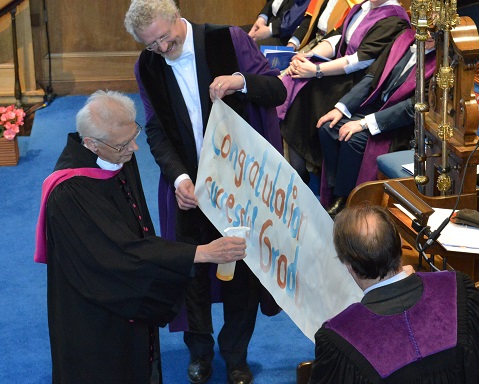Laureation address: Professor Herbert W Roesky

Laureated by Professor Derek Woollins, Vice-Principal (Research) and Provost of St Leonard’s College
Vice-Chancellor, it is my privilege to present Professor Herbert Walter Roesky for the degree of Doctor of Science, honoris causa.
I can think of no greater pleasure or honour than to be on the same stage as Herbert Roesky, one of the greatest synthetic inorganic chemists alive today. Roesky was born in 1935 in Laukischken, a small village in Eastern Prussia. His parents had a dairy and he learned this profession in Hannover. After two years he received the degree of a dairy expert. However, he didn’t find this a very interesting job and so he used the income from his dairy work to fund his training in chemistry. He earned his doctorate from the University of Göttingen in 1963, working on high pressure reactions of that most capricious element, fluorine. He was attracted to work at du Pont corporate labs in Wilmington, Delaware and then back to Germany firstly at Frankfurt but since 1980 in Göttingen.
It would be easy to spend the next few minutes listing the various prizes and honours he has received, and I shall mention some later, but I think Herbert would prefer me to talk about his chemical achievements. Synthetic inorganic chemistry is to my mind (and as a synthetic inorganic chemist how could I possibly be biased?) the most challenging of the chemical arts. There is beauty coupled with a need for technical excellence in a well-constructed inorganic synthesis with many of the molecules being fiercely determined to transform into something else in one way or another. Roesky’s work takes the science and art of chemical synthesis to a new level. His work takes us to the dizzy heights of molecular construction and architecture, combining technical brilliance with artistry to create truly beautiful molecules. Highlights include an electrochemical synthesis of the widely used triflic acid which is now used on the multi-tonne scale to supply the whole world market; cyclopentadienyl titanium trifluoride and other fluorinated half-sandwich complexes used as the best catalysts for preparing, for example, polystyrene; the preparation of silicon(II) compounds using trichlorosilane; the first stable monovalent aluminium alkyl; single silicon atoms stabilised by Lewis base molecules, a tantalum containing analogue of cyclophosphazene. The list could be expanded manyfold.
Roesky has published more than 1,200 scientific papers. His publications over five decades have contributed enormously to chemical research and education, especially in the fields of structure, bonding, and reactivity, and changed the teaching in chemistry. Roesky has established himself as a world leader in synthetic inorganic chemistry. He belongs to the generation of chemists who invented modern main-group organometallic chemistry over the last five decades with unusual and sustained creativity and originality. I should add that there is no past tense about his work, he published more than 20 papers in 2014; I hope this gives you an idea of his continuing energy and enthusiasm.
Apart from his prodigious research record Roesky has published four major books and 33 original papers on chemical education. His books have met with worldwide success. Chemical Curiosities, Chemie en Miniature, Spectacular Chemical Experiments, and Experiments in Green and Sustainable Chemistry represent major contributions to chemistry, its teaching and public image. His remarkable activities to enhance the public image and awareness of chemistry go beyond books and are indeed truly exceptional and unique. Travelling with a caravan to transport chemicals and equipment from Göttingen, Roesky has presented to the public the beauty and excitement of chemistry in memorable “experimental lectures”, given over 120 times in 17 countries. His superb and amusing chemical demonstrations, coupled with comments often in the language of the country, have entertained very broad audiences, from school children, teachers, parents to colleagues, and his performances are so famous that he can fill the largest lecture halls for a fascinating one-man show. With a unique blend of science, excitement, suspense and humour, he captures the attention of everyone and he has inspired countless young people to study chemistry whilst enhancing the general public’s understanding and perception of chemistry.
His outstanding achievements have been recognised through major national and international awards and prizes across the globe; numerous invited professorships and numerous honorary appointments in China, India, France, Romania and the USA. The awards are too many to list but some examples include membership of the German National Academy Leopoldina, of the TWAS (Third World Academy of Sciences), the European Academy of Sciences and a foreign membership of the French Academy of sciences and President of the Göttingen Academy of Sciences.
Thinking of how to sum up Roesky I am going to resort to one of my passions – football. Some of the graduands will know that I have had a lifetime of disappointment. Supporting Grimsby Town is not for the faint hearted. However, if I wanted to describe Roesky in footballing terms (forgive me if I show my age) I would have to say he combines the elegance and control of Franz Beckenbauer and Alan Hansen with the goal scoring of Bobby Charlton…in summary he is simply world class in every sense.
Vice-Chancellor, in recognition of his major contributions to chemistry I invite you to confer on Herbert Walter Roesky the degree of Doctor of Science, honoris causa.
Category Awards